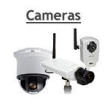
|
|
|
iCatcher Help
Learn how to set up and use iCatcher's features to their full potential. read more... File download areaDownload all the iCatcher software products, including legacy versions. read more... Wildlife picture galleryi-Catcher Wildlife captures fantastic scenes from nature. Have a look at some of the best. read more... Capture equipmentFind out about suitable equipment for use with iCatcher, from cameras to lighting, and more. read more... |
Configuring PTZ - Pan, Tilt & Zoom iCatcher Console is able to control a number of Pelco (using RS232 and RS485) and IP-based PTZ cameras. Other RS485 cameras can also be controlled by connecting them to suitable supported IP video servers. PTZ is configured in the feed settings, and requires that a PTZ driver is specified. This should match with your camera in terms of manufacturer and model. The IP address of the camera or device will need to be entered. If your camera uses authentication you will need to include this in the address. Pelco/RS485 cameras can be controlled direct from the PC serial port by specifying the Pelco RS485 driver and selecting the driver settings under Advanced. The following 'Address' examples demonstrate how authentication details can be added:
Preset positionsBy clicking on the Presets button, and selecting 'Edit Presets' you can configure a number of preset PTZ positions for your camera. There is one preset that can not be removed, which is the Home preset. This defines the default position for the camera, and is used when PTZ tracking is enabled. To add a new preset, move the camera using the PTZ movement controls to the required position, then click on 'New' to create a new preset at this position. You can also change an existing preset by selecting it, moving the camera, and clicking 'Set to current'. It is also possible to set a reference image for PTZ presets. This image will be used for the web view to give a visual reference as to the significance of the preset position. Note that some PTZ devices do not support accurate positioning
so the preset needs to be saved in the device itself. This means
that presets can be added and replaced but not deleted and any
changes made are applied immediately. PTZ preset cyclingThe PTZ preset cycling allows iCatcher Console to automatically cycle between a set of presets on a guard tour, staying on each preset for the configured length of time. Individual presets can be excluded from the preset cycling by unticking the "Include this preset in preset cycling". The home preset is always excluded. If the PTZ camera's position is controlled while preset cycling is active, the PTZ priority settings will take effect. PTZ TrackingIf the option to track motion is enabled in the PTZ settings for the feed, iCatcher Console will move the camera to follow the motion being detected. Once motion stops, Console will wait a moment then move the camera back to home position. Note: If you have "Track Motion" or "PTZ Cycling" enabled and you manually control the PTZ camera (either locally or from the web view) iCatcher will resume its automatic PTZ control 15 seconds after you finish. This can be configured in the PTZ priority settings. PTZ commandsSome PTZ drivers and devices support sending auxiliary commands the camera. Normally these are sent over Pelco P/D and similar protocols and make use of the high order preset numbers. iCatcher Console allows you to set these up using the PTZ command functionality which, if your device supports it, can be access by clicking the Presets button on the PTZ windows and Edit Commands. You can enter a name to identify this command. The Preset number and Action determine what is sent to the camera, whether it is a "go to preset X" command or "set preset x". Normally these details can be found in the manual for the camera or PTZ head. The Purpose option allows this command to be used for a special purpose, for example to activate the camera's own OSD menu. |
